Alienware Area-51 m9750: Power Gaming on the Go
by Jarred Walton on August 24, 2007 8:00 AM EST- Posted in
- Laptops
LCD Brightness, Contrast, and Viewing Angles
As always, we like to take a closer look at notebook displays to see how they measure up to the competition. We use ASTRA32 to probe for details about the LCD panel. However, ASTRA32 merely reads the information directly from the LCD panel using the VBE/DDC standard. Some LCD panels contain the wrong data, for example serial numbers, manufacturing date, etc. so we cannot guarantee all of the details are 100% accurate. Likewise, we cannot guarantee that the LCD panel used in our particular sample will be the same as that used in other notebooks of the same model.
ASTRA32 reports that the LCD panel in our test unit is an LG Philips LPL0B0A, manufactured in January 2005. Many of the notebook LCDs we've looked at have listed January 2005 as the manufacturing date, which seems a bit odd, so it may have been produced a bit more recently. However, looking at the LG Philips website, we could not find any details about this particular panel, which indicates that it was manufactured at least one if not two years ago. The overall display quality seems to be a bit better than some other 17" notebooks that we've seen, so Alienware may have purchased higher-quality LCD panels initially, but it's still safe to say that the LCD panel is a somewhat older model. Response times, color quality, and viewing angles are all pretty similar to what we've seen in other 1920x1200 17" notebooks.
Moving on to objective testing, we'll start with a look at brightness and contrast ratios along with viewing angles. We'll conclude on the following page with an examination of the color accuracy, before and after hardware calibration. For color accuracy, we are including results using ColorEyes Display Pro in addition to Monaco Optix XR Pro. Monaco Optix XR Pro uses the older ICCv2 profile specification and it may not be as accurate as software that uses the more recent ICCv4 specification. In testing we have discovered that there are certainly differences between the two software packages when it comes to color calibration, but neither one is universally better. We use a Monaco Optix XR Pro colorimeter (which is the same as the DTP-94) with both software packages.
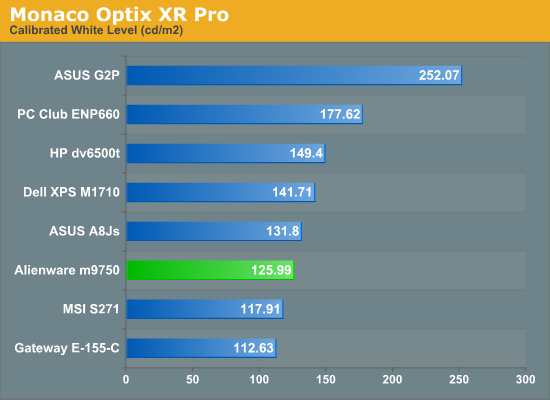
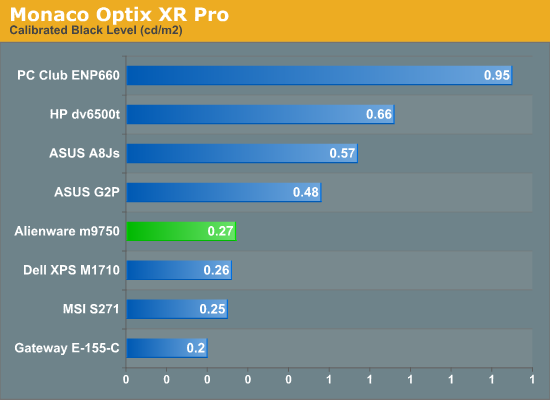
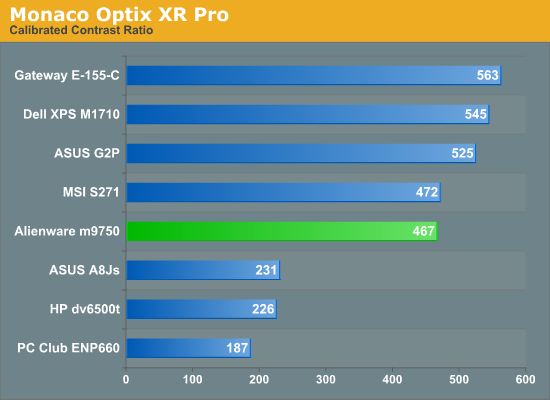
The calibrated white level is slightly lower than other LCDs, but maximum brightness prior to calibration was 146 nits, putting it on par with most other laptops. Black levels are also pretty good, and the result is a contrast ratio right around 500:1, give or take. (Without calibration, the black level was 0.28 resulting in a contrast ratio of 520:1.)
Turning down the brightness level rapidly reduces the display to the point where we wouldn't want to use it. Minimum brightness results in a white point of 6.65 nits and a black point of 0.01 nits, and while the measured contrast ratio actually goes up the quality certainly isn't better. There are eight total brightness settings available, but only the top four are really useful as the bottom four start with a white point of 50 nits and go down from there. The steps are also relatively coarse, changing the white level by 15-25 nits.
Brightness levels and contrast ratios aren't the only important aspects of a display, so here's a look at the viewing angles, taken at 30° from center. Images for the other laptops can be viewed using the links below.
ASUS A8Js
ASUS G2P
Dell M1710
HP dv6500t
Gateway E-155-C
MSI S271
PC Club ENP660
The viewing angles overall are pretty good for a laptop, ranking slightly ahead of most other laptops we've tested particularly in vertical viewing angles. In terms of overall quality we still prefer the ASUS G2P LCD, while the Gateway E-155-C has the best viewing angles.
Given that this is a gaming notebook, response times are going to be a bit more important. Using a 1/80s shutter speed, we can see remnants of at least four screen updates in the above image. Actual response times are thus similar to what we've seen in most other notebooks: somewhere between 25ms and 35ms. While that might seem slow for a modern LCD, consider that similar testing on "5 ms" LCDs indicates that they response times are also closer to 25ms in practical use. We weren't bothered by pixel smearing when using the notebook, but others may have more sensitive eyes. Test out some other laptops in person, and see if pixel smearing bothers you.
As always, we like to take a closer look at notebook displays to see how they measure up to the competition. We use ASTRA32 to probe for details about the LCD panel. However, ASTRA32 merely reads the information directly from the LCD panel using the VBE/DDC standard. Some LCD panels contain the wrong data, for example serial numbers, manufacturing date, etc. so we cannot guarantee all of the details are 100% accurate. Likewise, we cannot guarantee that the LCD panel used in our particular sample will be the same as that used in other notebooks of the same model.
ASTRA32 reports that the LCD panel in our test unit is an LG Philips LPL0B0A, manufactured in January 2005. Many of the notebook LCDs we've looked at have listed January 2005 as the manufacturing date, which seems a bit odd, so it may have been produced a bit more recently. However, looking at the LG Philips website, we could not find any details about this particular panel, which indicates that it was manufactured at least one if not two years ago. The overall display quality seems to be a bit better than some other 17" notebooks that we've seen, so Alienware may have purchased higher-quality LCD panels initially, but it's still safe to say that the LCD panel is a somewhat older model. Response times, color quality, and viewing angles are all pretty similar to what we've seen in other 1920x1200 17" notebooks.
Moving on to objective testing, we'll start with a look at brightness and contrast ratios along with viewing angles. We'll conclude on the following page with an examination of the color accuracy, before and after hardware calibration. For color accuracy, we are including results using ColorEyes Display Pro in addition to Monaco Optix XR Pro. Monaco Optix XR Pro uses the older ICCv2 profile specification and it may not be as accurate as software that uses the more recent ICCv4 specification. In testing we have discovered that there are certainly differences between the two software packages when it comes to color calibration, but neither one is universally better. We use a Monaco Optix XR Pro colorimeter (which is the same as the DTP-94) with both software packages.



The calibrated white level is slightly lower than other LCDs, but maximum brightness prior to calibration was 146 nits, putting it on par with most other laptops. Black levels are also pretty good, and the result is a contrast ratio right around 500:1, give or take. (Without calibration, the black level was 0.28 resulting in a contrast ratio of 520:1.)
Turning down the brightness level rapidly reduces the display to the point where we wouldn't want to use it. Minimum brightness results in a white point of 6.65 nits and a black point of 0.01 nits, and while the measured contrast ratio actually goes up the quality certainly isn't better. There are eight total brightness settings available, but only the top four are really useful as the bottom four start with a white point of 50 nits and go down from there. The steps are also relatively coarse, changing the white level by 15-25 nits.
Brightness levels and contrast ratios aren't the only important aspects of a display, so here's a look at the viewing angles, taken at 30° from center. Images for the other laptops can be viewed using the links below.
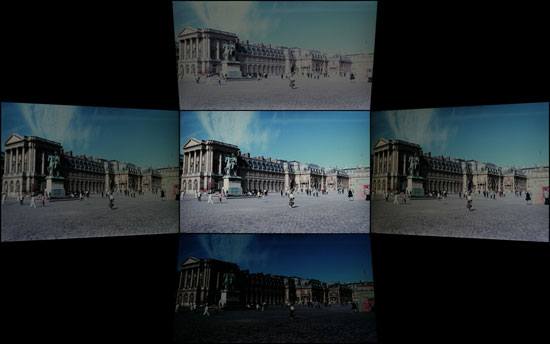 |
ASUS A8Js
ASUS G2P
Dell M1710
HP dv6500t
Gateway E-155-C
MSI S271
PC Club ENP660
The viewing angles overall are pretty good for a laptop, ranking slightly ahead of most other laptops we've tested particularly in vertical viewing angles. In terms of overall quality we still prefer the ASUS G2P LCD, while the Gateway E-155-C has the best viewing angles.
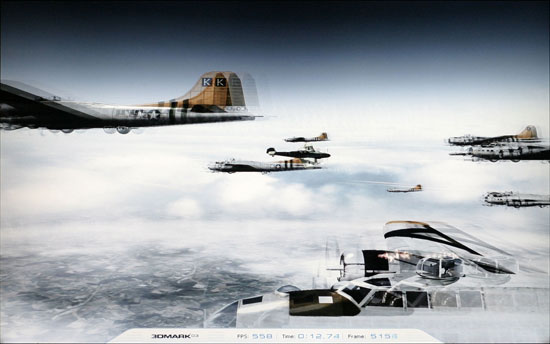 |
Given that this is a gaming notebook, response times are going to be a bit more important. Using a 1/80s shutter speed, we can see remnants of at least four screen updates in the above image. Actual response times are thus similar to what we've seen in most other notebooks: somewhere between 25ms and 35ms. While that might seem slow for a modern LCD, consider that similar testing on "5 ms" LCDs indicates that they response times are also closer to 25ms in practical use. We weren't bothered by pixel smearing when using the notebook, but others may have more sensitive eyes. Test out some other laptops in person, and see if pixel smearing bothers you.










26 Comments
View All Comments
Frumious1 - Friday, August 24, 2007 - link
Oop - was apparently posting at the same time as you. Count me for keeping the graphs as is!Marlin1975 - Friday, August 24, 2007 - link
It still uses the 945 chipset and not the newwer 965?I would think being on the cutting edge it would benifit fromt he new Mem. controller and other upgrades the 965 had?
toon26 - Saturday, September 8, 2007 - link
I have buy this portable with 4 giga of mémory but the bios reconize just 2559Mb of méméory.Commercial service of alienware For the small history my son comes to acquire this portable with option 4 giga of memory (it makes studies to become data-processing engineer) and appear that the BIOS of this portable recognizes only 2555Mo of memory.
The engineering department of Alienware is informed of a problem on this BIOS. The sales department of Alienware wants to offer a mouse well to my son for the damage undergoes (the option to pass from 2 to 4 giga has to cost 280 to him€, for a portable with 3400€)
Most comic of the history it is that the site of Alienware always proposes this option of the 4 gigas who is completely unusable so much than a new BIOS will not come to correct this problem.
All the tests which I could read on this portable in the newspaper industry or on Internet were made only with 2 giga of memory, and thus nobody could locate this BUG, not even the Alienware company which is praised to make pass more than 200 tests to your portable before sending it to you
JarredWalton - Saturday, September 8, 2007 - link
Which is why I have the following in the review:The OS options further cement the deal: no 64-bit, don't bother with the hugely expensive memory upgrade! And of course, for 64-bit you'd need new GPU drivers, which are MIA.
yacoub - Monday, September 3, 2007 - link
Nope, most major laptop manufacturers (Dell/Alienware being prime examples) seem to have a fetish for extremely over-priced laptops with outdated chipsets. Here, pay $5,000 and we'll give you 945 and DX9. WOW WHAT A DEAL! ;PJarredWalton - Friday, August 24, 2007 - link
It's a case of time to market. SLI notebooks were initially demoed at CES 2006. The first ones didn't show up until quite a bit later, and they were Go 7900 GTX cards. NVIDIA released the faster Go 7950 GTX, but I don't believe laptops supporting the faster cards became available until early 2007. Alienware probably doesn't have to resources to update their laptop line every time a new chipset comes out. Besides, they'd still have to deal with NVIDIA's driver updates (or lack thereof), and Santa Rosa wouldn't make that big of a difference in most titles - especially not in the GPU limited games.